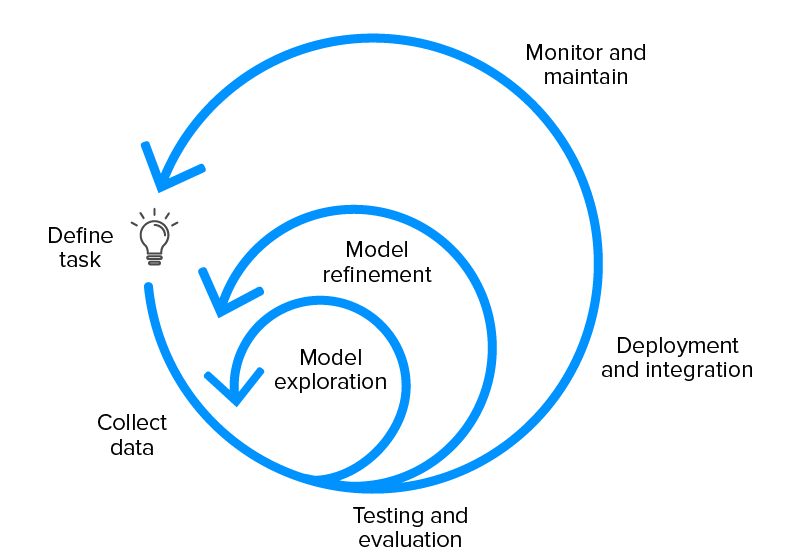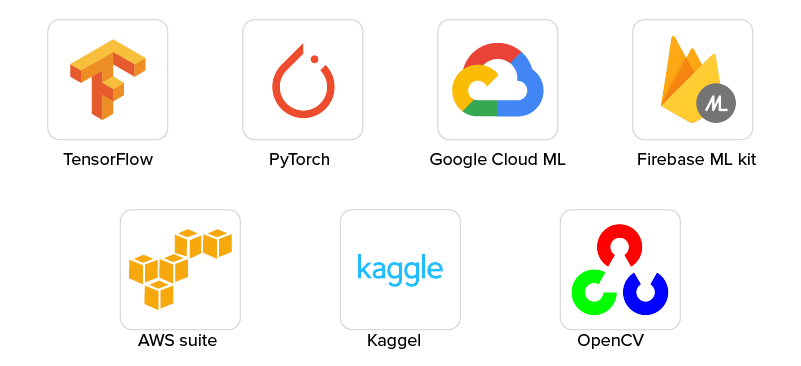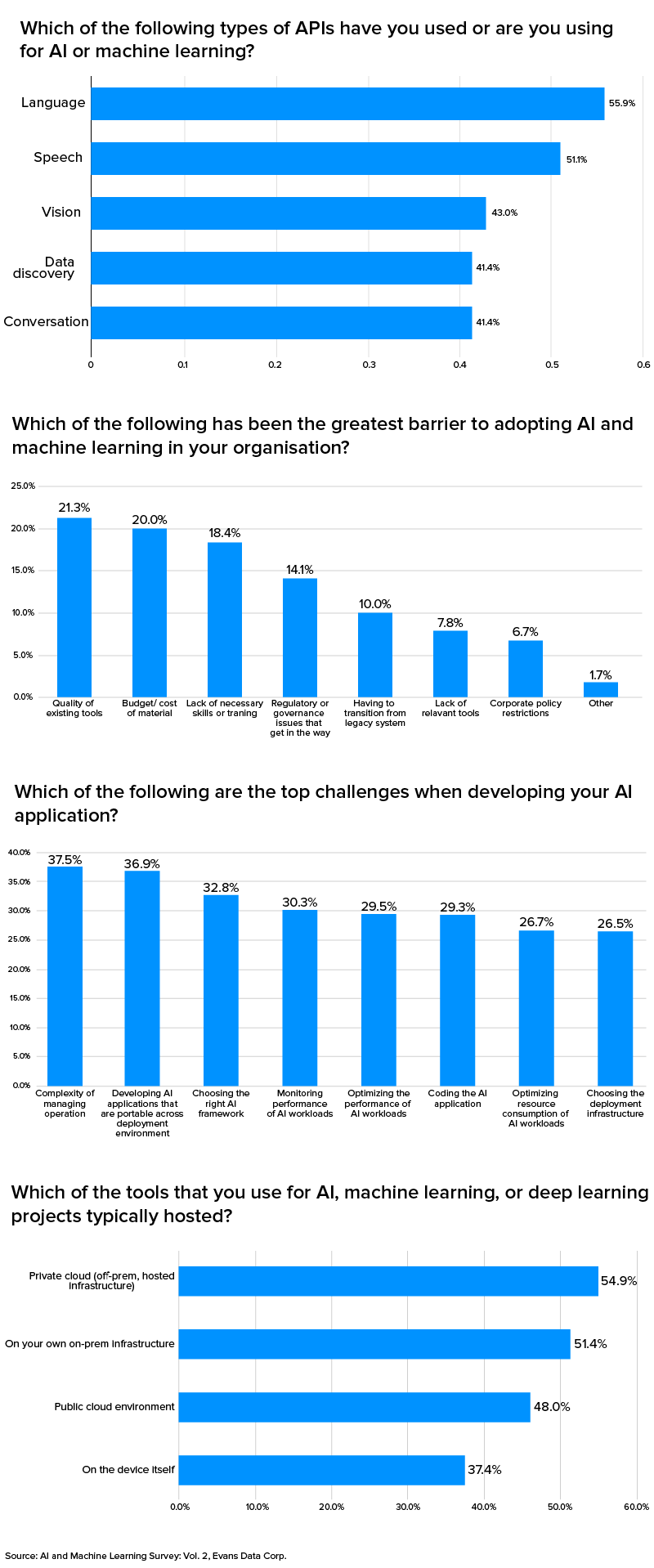Machine Learning is a two-sided coin.
On one side, it helps to eliminate uncertainties from processes. But on the other, its development is full of unsureties.
While the end result of almost every ML (Short for Machine Learning) project is a solution that makes businesses better and processes streamlined, the development part of it has a completely different story to share.
Even though ML has played a massive role in changing the profit story and business model of several established mobile app brands, it still operates under nascency. This newness, in turn, makes it all the more challenging for mobile application developers to handle an ML project plan and make it production ready, keeping the time and cost constraints in mind.
A solution (probably the only solution) to this difficulty is black and white Machine Learning app project estimate of the time, cost, and the deliverables.
But before we head on those sections, let us first look into what makes the difficulty and burning of the night candles worth it.
Why does your app needs a Machine Learning framework?
For Offering Personalized Experience
The extent of the answer to What is Machine Learning lies in the benefits that the technology offers to businesses by being a continual learning system. They can help in classifying the users based on the interest by collecting the users’ information and deciding on the app’s look and feel.
Businesses can make use of Machine Learning framework integration to learn –
- Who are their customers
- What do the customers want
- What preferences and hobbies do the users have, etc.
Based on the information, machine learning helps users in classifying and structuring their customers, finding a unique approach for every customer group, and adapting the tone of content.
For Incorporating Advanced Search
Machine Learning solutions make it possible for you to optimize the search functionality in a way that you are able to deliver more contextual results, making search a lot more intuitive and less burdensome for the users.
They also allow businesses to collect all the available information about the customers and rank them according to the best match.
For Predicting User Behaviour
Machine Learning based applications help businesses understand users’ choices and behavioural patterns by looking into different kinds of data:
- Age
- Gender
- Frequency of using app
- Location
- Search details, etc.
Using this data, it gets easier for businesses to plan their marketing strategy according to the individual user type.
For Better Security
In addition to being the effective marketing tool, machine learning can also help with the process of streamlining and securing the app authentication. ML powered facilities like voice, audio, and video recognition makes it easier for customers to authenticate with the help of biometric data like fingerprints or face. The machine learning algorithms can also help in identifying and banning suspicious activities on the app, in addition to preventing users from malware attacks.
For Deep User Engagement
Machine learning capabilities empower businesses to offer amazing customer support, endearing features, and entertainment value which gives users the incentive to use app on an everyday basis.
- Non Time-Bound Support
- Advanced Features Set
- Offering Entertainment
Types of Machine Learning Models
Machine learning, amidst its different use cases can be categorized into three model types, which play a role in turning rudimentary apps into intelligent mobile apps – Supervised, Unsupervised, and Reinforcement. The knowledge of what these Machine Learning Models stand for is what help define how to develop an ML enabled app.
Supervised Learning
It is the process where the system is provided with a data where algorithm’s inputs and their outputs are labeled correctly. Since the input and output information are labeled, system is trained to identify the patterns in data within the algorithm.
It becomes all the more beneficial for it is used to predict the outcome on the basis of future input data. An example of this can be seen when social media recognizes somebody’s face when they are tagged in a photograph.
Unsupervised Learning
In the case of unsupervised learning, the data is fed in system but its outputs are not labeled like in case of supervised model. It allows system to identify data and determine patterns from the information. Once the patterns are stored, all the future inputs are assigned to the pattern for producing an output.
An example of this model can be seen in cases where social media gives friends suggestion on the basis of several known data like demography, education background, etc.
Reinforcement Learning
Like in the case of unsupervised learning, the data which is given to the system in reinforcement learning is also not labeled. Both the machine learning type differs on the ground that when correct output gets produced, system is told that the output is right. This learning type enables the system to learn from the environment and experiences.
An example of this can be seen in Spotify. Spotify app makes a recommendation for song which the users then have to either gives a thumbs up or thumbs down. On the basis of the selection, Spotify app learns users’ taste in music.
Lifecycle of a Machine Learning project

The lifecycle of a Machine Learning project timeline usually appears like this –
A. ML Project Plan Setup
- Define the task and requirements
- Identify the project feasibility
- Discuss the general model tradeoffs
- Create a project codebase
B. Collection and Labeling of Data
- Create the labelling documentation
- Build the data ingestion pipeline
- Validation of data quality
C. Model Exploration
- Establish the baseline for model performance
- Create a simple model with initial data pipeline
- Try parallel ideas during the early stages
- Find the SoTA model for the problem domain, if any, and reproduce results.
D. Refinement of Model
- Do model-centric optimizations
- Debug models as complexity gets added
- Conduct error analysis for uncovering failure modes.
E. Test and Evaluate
- Evaluate the model on test distribution
- Revisit the model evaluation metric, ensuring it drives desirable user behaviour
- Write tests for – model inference function, input data pipeline, explicit scenarios expected in the production.
F. Deployment of Model
- Expose the model through REST API
- Deploy the new model to a subset of users to ensure that everything is smooth before the final rollout.
- Have the ability to roll back the models to its previous version
- Monitor the live data.
G. Model Maintenance
- Retrain the model for preventing model staleness
- Educate the team if there is a transfer in the model ownership
How to Estimate the Scope of a Machine Learning Project?
The Appinventiv Machine Learning team after perusing the Machine Learning type and the developmental lifecycle goes on to define the Machine Learning app project estimate of the project following these phases:
Phase 1 – Discovery (7 to 14 days)
The ML project plan roadmap begins with the definition of a problem. It looks into the issues and operational inefficiencies which should be addressed.
The goal here is to identify the requirements and see if Machine Learning meets the business goals. The stage requires our engineers to meet with the business people on the client side to understand their vision in terms of what issues they are looking to solve.
Secondly, the development team should identify which kind of data they have and if they would need to fetch it from outside service.
Next, developers have to gauge if they are able to supervise algorithms – if it returns correct response every time a prediction is made.
Deliverable – A Problem Statement which would define if a project is trivial or or would it be complex.
Phase 2 – Exploration (6 to 8 weeks)
The goal of this stage is to build upon a Proof of Concept which can then be installed as API. Once a baseline model is trained, our team of ML experts estimate the performance of the production-ready solution.
This stage gives us the clarity on what performance should be expected with the metrics planned at the discovery stage.
Deliverable – A Proof of Concept
Phase 3 – Development (4+ months)
This is the stage where the team works iteratively till they reach a production ready answer. Because there are far less uncertainties by the time the project reaches this stage, the estimation gets very precise.
But in case the result is not improved, developers would have to apply different model or rework on the data or even change the method, if needed.
In this stage, our developers work in sprints and decide what is to be done after every individual iteration. The outcomes of every sprint can be predicted effectively.
While the sprint outcome can be predicted effectively, planning for sprints in advance can be a mistake in case of Machine Learning, for you will be working on uncharted waters.
Deliverable – A production ready ML solution
Phase 4 – Improvement (continuous)
Once deployed, decision makers are almost always in a hurry to end the project to save costs. While the formula works in 80% of the projects, the same doesn’t apply in Machine Learning apps.
What happens is that the data changes throughout the Machine Learning project timeline. This is the reason why an AI model has to be monitored and reviewed constantly – to save it from degradation.
The Machine Learning centered projects require time for achieving satisfying outcomes. Even when you find your algorithms beating the benchmarks right from the beginning, chances are that they would be one strike and the program might get lost when used on a different dataset.
How We Estimate the Cost of a Machine Learning Project?
When we talk about the estimation of the cost of a machine learning project, it is important to first identify which project type is talked about.
There are majorly three types of Machine Learning projects, which hold a role in answering How much does Machine Learning cost:
First – This type already has a solution – both: model architecture and dataset already exists. These types of projects are practically free, so we won’t be talking about them.
Second – These projects need fundamental research – application of ML in a completely new domain or on a different data structures compared to mainstream models. The cost of these projects type are usually one which majority of startups cannot afford.
Third – These are the ones we are going to focus on in our cost estimation. Here, you take model architecture and algorithms which already exist and then change them to suit the data you are working on.
Let us now get to the part where we estimate the cost of the ML project.
The data cost
Data is the primal currency of a Machine Learning project. Maximum of the solutions and research focuses on the variations of the supervised learning model. It is well known fact that the deeper the supervised learning goes, the greater are the need for annotated data, and in turn, the higher is the Machine Learning app development cost.
Now while services like Scale and Amazon’s Mechanical Turk can help you with gathering and annotation of data, what about Quality?
It can be extremely time consuming to check and then correct the data samples. The solution to the issue is two faced – either outsource the data collection or refine it in-house.
You should outsource the bulk of the data validation and refinement work and then appoint one or two people in-house for cleaning the data samples and labeling it.
The research cost
The research part of the project, as we shared above, deals with the entry level feasibility study, algorithm search and the experimentation phase. The information which usually surfaces from a Product Delivery Workshop. Basically, the exploratory stage is the one every project goes through before its production.
Completing the stage with its utmost perfection is a process that comes with an attached number in the cost of implementing ML discussion.
The production cost
The production part of Machine Learning project cost is made up of infrastructure cost, integration cost, and maintenance cost. Out of these costs, you will have to make the least expenses with the cloud computation. But that too will vary from the complexity of one algorithm to another.
Integration cost varies from one use case to another. Usually, it is enough to put an API endpoint in cloud and document it to then be used by rest of system.
One key factor that people tend to overlook when developing a machine learning project is the need to pass continuous support during the entire lifecycle of the project. The data which comes in from APIs have to be cleaned and annotated properly. Then, the models have to be trained on new data and tested, deployed.
In addition to the points mentioned above, there are two more factors that carry an importance on the estimation of the cost to develop an ML project.
Frameworks Used to Develop a Machine Learning System

As you can see from the image above, there are a number of frameworks that can be used to define an ML app techstack. The ones that we most commonly use in the development of ML app in house are:
TensorFlow – It is a general purpose Machine Learning framework that covers a wide array of use cases. Parented by Google, it is one of the most used frameworks for development and deployment of ML apps.
Firebase ML Kit – It provides an easy to use cloud API for the purpose of image processing tasks such as – barcode scan, text detection, face detection, and logo detection.
OpenCV – the framework is by far one of the most popular machine learning and computer vision library. Operating in an open source model, it is available on multiple platforms for developers to create computer vision centric apps.
Challenges in developing Machine learning apps

Usually, when a Machine Learning app project estimate is drawn, the developmental challenges associated with it are also kept into consideration. But there can be instances where the challenges are found mid-way of the ML powered app development process. In cases like these, the overall time and cost estimation automatically increases.
The challenges for Machine Learning projects can range from:
- Deciding what set of features would become machine learning features
- Talent deficit in AI and Machine Learning domain
- Acquiring data sets is expensive
- It takes time to achieve satisfying results
Conclusion
Estimating the manpower and time needed to finish a software project is relatively easy when it is developed on the grounds of modular designs and is handled by an experienced team following an Agile approach. The same, however, becomes all the more difficult when you work on creating the time and efforts wise Machine Learning app project estimate.
Eventhough the goals might be well-defined, the guarantee of whether or not a model would achieve the desired outcome is not there. It is not usually possible to lower the scope and then run the project in time boxed setting through a predefined delivery date.
It is of prime importance that you identify that there will be uncertainties. An approach that can help mitigate delays is ensuring that input data is in the right format for Machine Learning.
But ultimately, no matter which approach you plan to follow, it will only be deemed successful when you partner with a Machine Learning app development agency that knows how to develop and deploy the complexities in their simplest form.
FAQs about Machine Learning app project estimate
Q. Why use Machine Learning when developing an app?
There are a number of benefits that businesses are able to avail with the incorporation of Machine Learning into their mobile apps. Some of the most prevalent ones are on the app marketing front –
- Offering personalized experience
- Advanced search
- Predicting user behaviour
- Deeper user engagement
Q. What are the benefits of Machine Learning for businesses?
The benefits of Machine Learning for businesses goes beyond marking them as a disruptive brand. It ripples down to their offerings becoming more personalized and real-time.
Machine Learning can be the secret formula that brings businesses closer to their customers, just how they want to be approached.
Q. How to estimate ROI on developing Machine learning project?
While the article would have helped you in establishing the Machine Learning app project estimate, calculating ROI is a different game. You will have to keep into consideration the opportunity cost in the mix as well. Additionally, you’ll have to look into the expectation that your business has from the project.
Q. Which platform is better for an ML project?
Your choice of whether to connect with an Android app development company or with iOS developers will depend entirely on your user base and the intent – whether it is profit making or value centric.
IT Managed & Outsourcing
Didn't find what you're looking for? Let us know your needs, and we'll tailor a solution just for you.

























